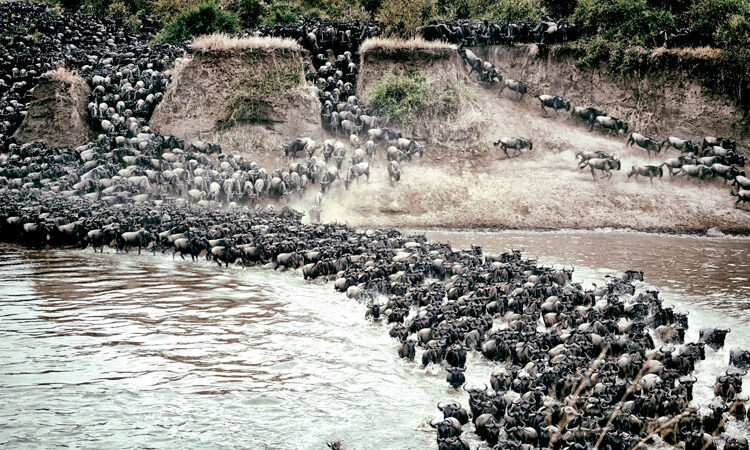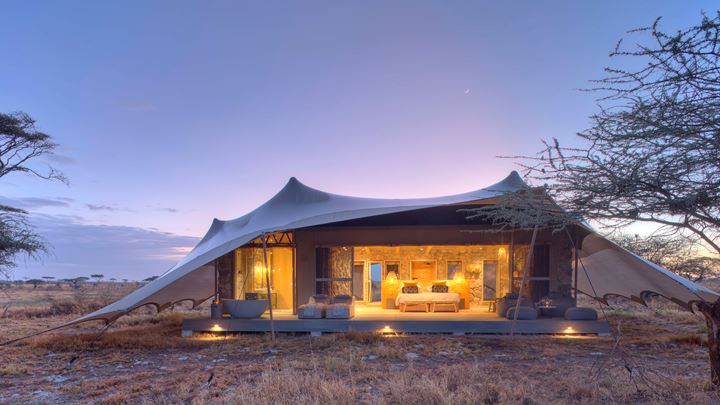The Great Wildebeest Migration River Crossings : Every year, around 1.5 million wildebeest migrate in a massive circle. The yearly migration northwest at the conclusion of the rainy season, which is typically in May or June, is one of the “Seven Wonders of the Natural World.”

The antelope family includes wildebeest, sometimes known as gnus. They have kinship with oryxes and gazelles. A wildebeest may reach a length of 2.4 meters and weigh up to 270 kilograms. The Serengeti grasslands of southern Africa are home to wildebeest. Wildebeest spend the most of their life grazing on the grassy savannas and open forests of Tanzania and Kenya’s lowlands.
Understanding the Great Wildebeest Migration River Crossings.
The majority of people associate the ‘Great Migration’ with the renowned wildebeest river crossings that occur in the Masai Mara and Serengeti during peak safari season, from June to October.
The Great Migration is a year-long cyclical event in which wildebeest and other plains game follow the rains from the east of the Serengeti down through the north-west of Ngorongoro Conservation Area, back up through the Serengeti’s central and west, all the way up north to the Masai Mara, and then back down through the Serengeti’s center and east.
There can be plenty of action to be found throughout the annual Great Migration, with calving season from January to March, rutting season in April and May, and river crossing season from June to October, with the herd continuing to move south in November and December — only to repeat the cycle. Most visitors consider the river crossings to be the most thrilling and desirable portion of the Great Migration to experience, and they are a must-do on their bucket list.
Why you should book a Safari to witness the Great Wildebeest Migration River Crossings?
The sheer number of wildebeest, zebra, and gazelles is awe-inspiring, with 1.3 million wildebeest and 300,000 zebra taking part in the world’s greatest herd migration — so vast, in fact, that it can be seen from space.
The stunning river crossings are thrilling to see, but you must be patient to see this show firsthand. Wildebeest can take hours to days to traverse the Mara and Sand Rivers from Tanzania’s Serengeti to Kenya’s Masai Mara. The herd impatiently awaits one of its colleagues to take the first literal step.
However, it is a frightening proposition to begin with, with crocodiles in the river and lions and other large cats waiting on the opposite side of the river to prey on the weaker members of the herd. There’s the muddy riverbank to avoid getting trapped in, and some sides of the ravine turn out to be too steep to climb up, driving the herd back across the hazardous river to repeat the practice!
Finally, one courageous wildebeest makes their first stride or rather jump into the river, producing a cascade movement of the entire herd — one after the other in a synchronized effect – a must-see occurrence.
Reasons Why the Great Wildebeest Migration River Crossings happen.
The rain is followed by the wildebeest by following the movement of the rain clouds. They know that when there is a lot of rain, the grass they eat will grow quickly. They are driven by instinct to follow the storm clouds over the Mara and Sand rivers.
Where to stay during the Great Migration River Crossings?
Asilia Camps
We offer four sites in the northern Serengeti and Masai Mara that are perfectly located to witness the spectacular wildebeest river crossings. Each camp has its own distinct character, providing a variety of safari accommodations for all types of travelers. You can expect the warm welcome, sought-after places, and excellent guiding that Asilia is known for.

Ubuntu Migration Camp
With 10 classic canvas tents, hot-water safari bucket showers, and open verandas overlooking the huge plains of grunting wildebeest as they make their journey to the Mara River, Ubuntu Migration Camp exemplifies the early days of safari.
Olakira Migration Camp.
Olakira Migration Camp has eight stunning stargazing tents with 270-degree views from your bed – the mesh-covered tents provide protection while letting you to sleep beneath a sky filled with brilliant stars. During the day, your housekeeper rolls the bed away, transforming the room into your own private observation deck with sofa, allowing you to hear and watch the wildebeest herds travel past camp up into the Masai Mara for the spectacular river crossings.


